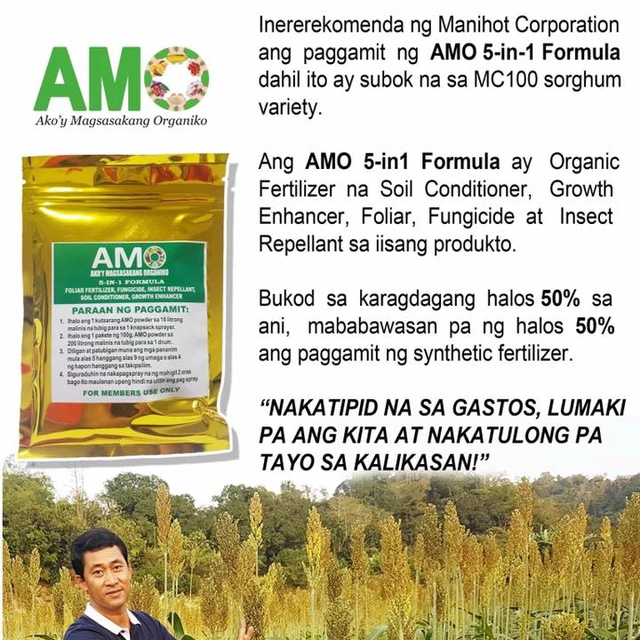AFTER
IT SHOWED ROBUST HIGHLY PROTECTED POMELO TREES
By
Mortz C. Ortigoza
M’LANG,
Cotabato Province – Farmers in this sweetest producing pomelo town are expected to shift to AMO Growth Enhancer after a
major planter attested how the Enhancer will save them tens if not
hundreds of thousands of pesos for their crops' protection against
pests and diseases.
Jerry
Reyes, a resident of Brgy. New Janiuay here, said that it cost him an
arm and a leg spraying with pesticide every other day his countless
of hectares of pomelo trees to maintain their sweetness and to deflect
attacks by bugs, fungi, and others.
“I
only used three drums (of water) I poured and mixed them each with a sachet of
AMO,” he said about the growth enhancer dubbed as miracle
fertilizer he bought at P750 each from Nathanael Fabila who is a
renowned seed distributor in Mindanao and manager of AMO Fertilizer
there.
| Pomelo fruits and their healthy leaves. |
Since
he shifted from the more expensive fungicide and pesticide to AMO in
June 14 this year, Reyes a retiring Captain of the Bureau of Fire of
Philippines, started to spray 60 trees, or hills as farmers call them,
by eight days interval. Because of it he saw the leaves of the trees
became greener, fatter, and more conditioned thanks to the growth
enhancer manufactured in Calasiao, Pangasinan and became popular in
Northern Luzon particularly.
"After my second spray I will make the interval by 15 days to save on fungicide".
AMO
is kelp based fertilizer. It contains
only small amount of N, P, and K, it means highest in Potash but adds
valuable micro nutrients,
natural growth hormones, and vitamins that help increase yields,
improve soil structure, reduce plant stress from drought, and
increase frost tolerance.
“I
saw there maggots shunning the trees and they were
thinner,” he cited after he sprayed with AMO the manure from
his poultry houses he used as natural fertilizer of the big citrus
trees.
There
are now less falling leaves in between the stretch of the trees
because of the sturdy leaves.
| ALTERNATIVE. Cotabato Province’s pomelo planter Jerry Reyes (left photo) listens attentively to plant growth enhancer AMO’s Mindanao Executive Nathanael Fabila who explains to the former the pilot project he will venture into countless trees of the sweetest big citrus tree to be sprayed every 15 days with the growth enhancer. AMO will replace the more expensive pesticide, herbicide, and fungicide Reyes use to the leaves of his tree every other day. |
Eleonor
“Lotlot” Alba- Antonio, an
executive of the hundreds of hectares’ Sheba Pomelo Farm,
said that in her countless of years as supervisor of planters of huge
hectares of pomelo in the provinces of Cotabato, South Cotabato,
Sarangani, and Davao, the sweet pinkish if not red pulp fruit planted here is the tastiest.
“Aside
from the combination of proper care, right fertilizers and pesticides
the factor of its being the sweetest is the soil of this
town,” Antonio told this
writer in her 24 hectares of the scientifically known citrus
grandis' plantation in
Barangay Buayan here.
But
venture in these fruits entail a huge expenses because they are
fertilizer and pesticide pampered from a farmer.
You
have to wait for five years and the harvest is twice a year. A farmer
earned a gross of one million pesos in one hectare per harvest or a
net profit of five hundred thousand pesos (per harvest or one
million pesos in two harvests a year with one million pesos in fertilizers,
pesticides, labor, and other expenses - Author),”
she cited.
Many
farmers here, including those former rubber and palm oil planters,
shifted to pomelos because of the hefty returned of investment.
AMO is a 5-in-1 formula developed by lawyer Eric G. Acuna, a former congressman, where a farmer can use it as organic fertilizer, soil conditioner, growth enhancer, foliar, fungicide, and insect repellent.READ:
M'lang Produces The Tastiest, Sweetest Pomelo
 |
SWEET.
Pomelo tree and fruits in New Janiuay, Mlang Cotabato. The rustic
landlocked town is a major producer of the bitter sweet fruits in the
country. The person in the photo is the author.
|

(Send
comment to totomortz@yahoo.com)

How much po per sachet.
ReplyDeleteMagkano po per sachet at san ba mkabibili,myron ba sa tacloban yan o sa borongan,
ReplyDeleteWhere can we buy AMO?
ReplyDelete